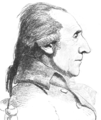
Patrick Russell (herpetologist)
Encyclopedia

Scotland
Scotland is a country that is part of the United Kingdom. Occupying the northern third of the island of Great Britain, it shares a border with England to the south and is bounded by the North Sea to the east, the Atlantic Ocean to the north and west, and the North Channel and Irish Sea to the...
surgeon and naturalist who worked in India
India
India , officially the Republic of India , is a country in South Asia. It is the seventh-largest country by geographical area, the second-most populous country with over 1.2 billion people, and the most populous democracy in the world...
. He studied the snakes of India and is considered the 'Father of Indian Ophiology
Ophiology
Ophiology is a branch of herpetology, the study of reptiles and amphibians, and deals with the scientific study of snakes, including the natural history and behavior of the animals. An individual who studies snakes is known as an ophiologist...
'. The Russell's viper, Daboia russelii
Daboia
Daboia is a monotypic genus of venomous Old World viper. The single species, D. russelii, is found in Asia throughout the Indian subcontinent, much of Southeast Asia, southern China and Taiwan...
, is named after him.
He was born in Edinburgh to John Russell as the half-brother of Alexander Russell, FRS and William Russell, FRS. He was educated in Edinburgh where he qualified MD. He joined his half-brother in Aleppo
Aleppo
Aleppo is the largest city in Syria and the capital of Aleppo Governorate, the most populous Syrian governorate. With an official population of 2,301,570 , expanding to over 2.5 million in the metropolitan area, it is also one of the largest cities in the Levant...
, Syria in 1750 and succeeded him as physician to the East India company factory there. He was a keen observer and skilled in clinical practice and he applied his medical skills in Aleppo during an outbreak of the plague
Bubonic plague
Plague is a deadly infectious disease that is caused by the enterobacteria Yersinia pestis, named after the French-Swiss bacteriologist Alexandre Yersin. Primarily carried by rodents and spread to humans via fleas, the disease is notorious throughout history, due to the unrivaled scale of death...
.
In 1772 he returned to Englandto practice medicine in London.
He then travelled to Vishakapatnam in Madras Province, India in 1781 at the age of 54 to look after his half-brother who still worked with the East India Company
British East India Company
The East India Company was an early English joint-stock company that was formed initially for pursuing trade with the East Indies, but that ended up trading mainly with the Indian subcontinent and China...
there. He took a great interest in the plants of the region leading to his appointment in 1785 as the company's 'Botanist and Naturalist' in the Carnatic region of the Government of Madras. This post, according to Ray Desmond (1992, European Discovery of Indian Flora) was:
- The Company's expectations of their Naturalist were excessively optimistic. He was presumed to be a linguist, demographer, antiquarian, meteorologist, mineralogist and zoologist (in addition to being a botanist).
He wrote about the plant and animal life of Madras as he had of that of Aleppo. As a physician as well as a naturalist to the East India Company in the Carnatic
Carnatic region
The Carnatic coast is the region of South India lying between the Eastern Ghats and the Coromandel Coast, in the modern Indian states of Tamil Nadu, south eastern Karnataka and southern Andhra Pradesh....
he was concerned with the problem of snakebite
Snakebite
A snakebite is an injury caused by a bite from a snake, often resulting in puncture wounds inflicted by the animal's fangs and sometimes resulting in envenomation. Although the majority of snake species are non-venomous and typically kill their prey with constriction rather than venom, venomous...
and made it his aim to find a way for people to identify venomous snakes. He spent six years in the Madras presidency during which period he sent a large collection of snakes to the British Museum
British Museum
The British Museum is a museum of human history and culture in London. Its collections, which number more than seven million objects, are amongst the largest and most comprehensive in the world and originate from all continents, illustrating and documenting the story of human culture from its...
. He wrote a two volume work An Account of Indian Serpents Collected on the Coast of Coromandel which included drawings done by him. Part of the work was published posthumously. He also made a large collection of plants.

